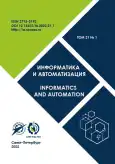Volume 21, Nº 1 (2022)
Digital information telecommunication technologies
Mathematical Model and Algorithm of Branch and Boundary Method for Optimizing Solutions for Package Compositions in Multi-Stage Systems
Resumo
 5-40
5-40


On the Expediency and Possibilities of Approximating a Pure Delay Link
Resumo
When solving problems of controlling an object with delay, it is often necessary to approximate a pure delay link with a minimum phase link in order to ensure the possibility of using analytical methods for regulator design. There are many approximation methods based on the Taylor series expansion, as well as modified methods. The most famous one is the Padé approximation method. The known approximation methods have significant drawbacks, which this paper reveals. However, there are other methods of forming other types of filters that can serve as a better approximation in determining the delay relationship, although they are not used for these purposes. In particular, methods of forming the desired differential equation of a locked-loop system of a given order by the method of numerical optimization are known. In this case, the locked-loop system behaves like a filter of the corresponding order, the numerator of which is equal to one, and the specified polynomial is in the denominator. Modeling has shown that such a filter is an effective alternative approximation of the delay link and can be used for the same purposes for which it was supposed to use the Padé approximation. The polynomial coefficients in the literature were calculated only up to the 12th order. The higher the polynomial order is, the more accurate the approximation is.
 41-67
41-67


Theoretical Aspects in Forming Complex Structure Signal
Resumo
 68-94
68-94


Properties of Harmonic and Composite Half-Waves, Determination of the Uniform Time Sampling Interval of Digital Signal Processors
Resumo
 95-125
95-125


Artificial intelligence, knowledge and data engineering
Hybrid Network Structures and Their Use in Diagnosing Complex Technical Systems
Resumo
 126-160
126-160


Polynomial Approximations for Several Neural Network Activation Functions
Resumo
 161-180
161-180


A SLAM system based on Hidden Markov Models
Resumo
Methods of simultaneous localization and mapping (SLAM) are a solution for the navigation problem of service robots. We present a graph SLAM system based on Hidden Markov Models (HMM) where the sensor readings are represented with different symbols using a number of clustering techniques; then, the symbols are fused as a single prediction, to improve the accuracy rate, using a Dual HMM. Our system’s versatility allows to work with different types of sensors or fusion of sensors, and to implement, either active or passive, graph SLAM. A graph-SLAM approach proposed by the International’s Karto Robotics in Cartographer, the nodes represent the pose of the robot and the edges the constraints between them. Nodes are usually defined according to contiguous nodes except when loop closures are detected where constraints for non-contiguous nodes are introduced, which corrects the whole graph. Detecting loop closure is not trivial; in the ROS implementation, scan matching is performed by Sparse Pose Adjustment (SPA). Cartographer uses an occupancy map in order to estimate the position where the map representation is done via Gmapping. The Toyota HSR (Human Support Robot) robot was used to generate the data set in both real and simulated competition environments. In our SLAM representation, we have wheel odometry estimate according to initial position of the robot, a Hokuyo 2D Lidar scan for observations, and a signal control and a world representation is estimated. We tested our system in the kidnapped robot problem by training a representation, improving it online, and, finally, solving the SLAM problem.
 181-212
181-212











